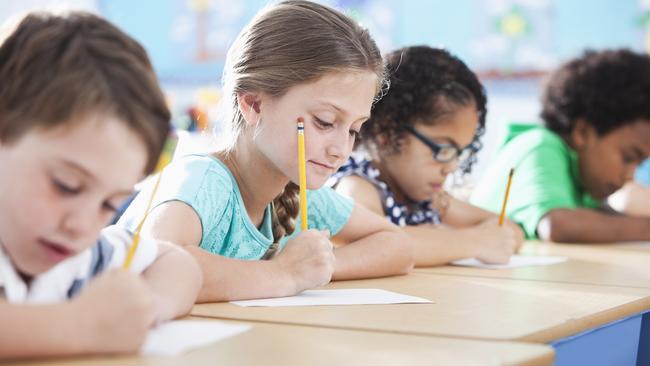SA students perform below national benchmarks in NAPLAN report for 2019
NAPLAN results for last year show a decline in high-achieving South Australian students, as well as a drop in those showing up for the tests.
- Uni cheats prosper in exams
- SA’s top performing schools in NAPLAN from 2014-18
- Anxious kids at crisis point
Fewer South Australian students achieved high scores on their NAPLAN literacy and numeracy tests last year compared with those in most other states, a new report shows.
The NAPLAN National Report for 2019 shows that across the test categories, an average of 9 per cent of SA students reached high achievement levels, compared with a national average of 12.7 per cent.
Students in NSW had the best outcomes with 14.1 per cent being high achievers, followed by Victoria (13.4 per cent) and the ACT (12.7 per cent). The Northern Territory (5.3 per cent) was the only place with a smaller proportion of high achievers than SA.
The report reveals fewer SA students showed up for their NAPLAN tests compared with many other jurisdictions. SA’s worst participation rate was in Year 9, at 88.3 per cent.
Despite improvements last year, SA students still performed below national benchmarks in writing, with an average of 88.6 per cent of students at or above the minimum standard, compared with 90.2 per cent nationally.
Year 3s and 5s had the second lowest proportion of students meeting or exceeding the writing standard across the country, next to the Northern Territory. The report shows children of senior managers and professionals performed on average 7.6 per cent better than children of labourers, hospitality workers, machine operators and assistants.
Longer term, there have been some improvements.
The state’s reading scores have generally risen since NAPLAN testing began in 2008, particularly for Years 3 and 5 students.
SA Education Minister John Gardner said the State Government was investing heavily in schools to improve writing results.
“We have taken on new literacy coaches to work with schools that need extra support, particularly in this area, and we have invested more broadly in education with funding growth for schools in every budget we’ve delivered,” Mr Gardner said.
An Education Department spokeswoman said more funding was going to schools that needed it most.
“Parental education and occupation are two indicators of a student’s socio-economic background,” the spokeswoman said.
“There is a link between a student’s socio-economic background and academic outcomes. (We’re) providing proportionally more funding to schools with lower socio-economic status.”

The principal of Catholic school Rostrevor College, Brian Schumacher, said NAPLAN was “a really useful diagnostic tool” but its importance should not be blown out of proportion.
“We don’t have the hype around NAPLAN results that perhaps occurs (elsewhere),” he said. “I’ve seen the same students (score low) in NAPLAN, but (later on) they’re up there in the highest ATAR (university entry) scores and go on to do wonderful things.”
Rostrevor parent Shipra Sareen, whose sons Vivaan, 11, and Aaryan, 13, took part in NAPLAN tests last year, said it was important for her and husband Hemant to incorporate reading and writing in their children’s days.
“From the very beginning, we’d read books to them and do a lot of story telling,” Mrs Sareen said. “We celebrated a lot of the smaller achievements along the way (and) motivated them along the way.”
Federal Education Minister Dan Tehan said NAPLAN was essential in determining the progress and outcomes of schools.
“Literacy and numeracy must be the absolute fundamentals of a world-leading education,” Mr Tehan said.
